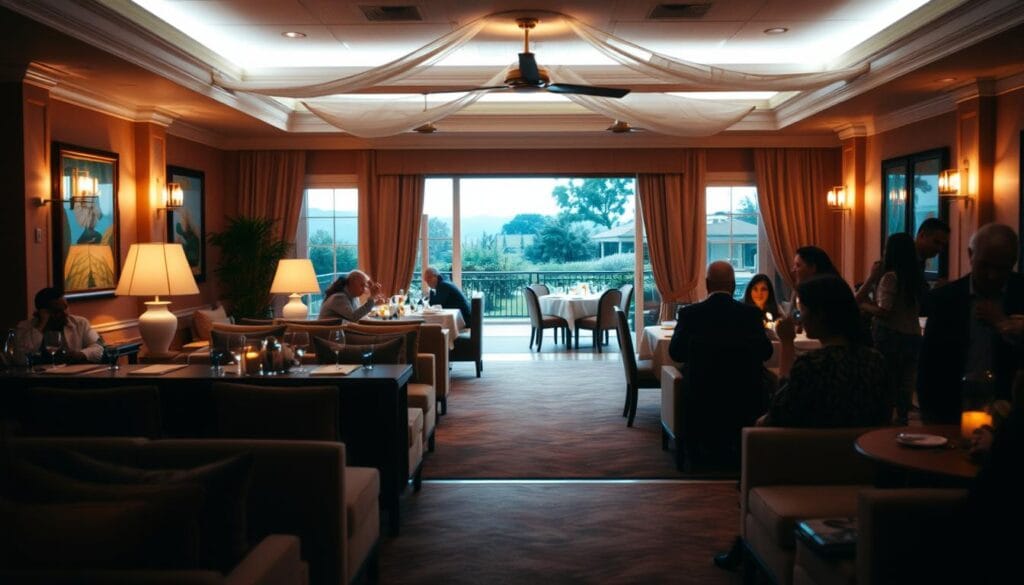Surprising fact: nearly one in three celebratory events exceed budget when hosts skip an early budget checklist.
Honoring a long career is a big milestone that feels better with simple, early steps. Start by naming what success looks like for the retiree and set a clear budget to steer every choice.
A practical per‑guest benchmark is $50–$100, while venue rentals often run $500–$2,000 and catering $30–$75 per person. Choosing a date that works for family, friends, and close colleagues avoids conflicts and keeps attendance high.
Tip: All‑in‑one venues that bundle catering and desserts simplify logistics—local options like Celebrations Dothan show how a combined space and in‑house menu saves time.
Next, craft a theme tied to hobbies or travel, make a focused guest list, and build a program with toasts and memory moments. For more on income and future planning, see this useful guide.
Key Takeaways
- Set a budget early to guide venue, food, and entertainment choices.
- Use per‑guest benchmarks and average cost ranges to avoid surprises.
- Pick a date that suits the retiree and most important guests.
- Consider bundled venues to simplify logistics and reduce stress.
- Choose a personal theme and plan memory moments to honor the honoree.
Set the Foundation: Scope, Budget, and Party Style

Set the foundation with a tight team and a clear headcount goal so choices stay smart. Start by assembling colleagues who know the retiree and can share tasks. Agree on a target guest list—20–50 people keeps the gathering intimate and manageable.
Committee and scope
Give each volunteer a clear role: project lead, budget manager, RSVP/guest list owner, décor lead, and program/MC. Decide the date window and the venue type—home, restaurant, workplace function room, or event space. Note whether the celebration will be a surprise or planned with the honoree.
Budget smart
Use a per-guest benchmark of $50–$100 and itemize big-ticket lines first. Typical ranges: venue rental $500–$2,000; catering $30–$75 per person; décor $200–$500; entertainment $300–$1,000. Build the budget top-down and bottom-up to catch scope creep.
Choose the tone
Match the style to the retiree’s preferences and hobbies. Options include a casual cookout, cocktail reception, afternoon tea, or formal sit-down dinner. Shortlist catering options—full-service, drop-off buffet, or restaurant preorder—and confirm dietary needs early.
Document assumptions in a simple list so the committee stays aligned and surprises stay small.
Lock the Essentials: Date, Time, Venue, and Guest List

Choosing the right day and time starts with checking a few people’s calendars first. Poll the retiree and a handful of essential guests to identify blackout dates and find a slot that avoids major events.
Pick a date and timing: Many organizers work on a 2–3 month window to secure popular venues and caterers. Weekday late afternoons suit workplace gatherings; weekend evenings work best for family and friends who prefer dinner events.
Venue options and capacity
Compare workplace function rooms, homes/backyards, restaurants, parks, community halls, and event spaces. Confirm capacity, ADA access, parking, noise limits, and AV needs before booking.
- Bundle services: Choose venues that include in‑house catering or dessert options to simplify logistics.
- Layout plan: Map entrance, check‑in, seating, stage, and a screen or photo area to shape the atmosphere.
- Company rules: If on company property, confirm after‑hours access and alcohol or AV policies.
Build a meaningful guest list
Create the guest list with the retiree and include family, close friends, colleagues, mentors, and key collaborators. Use a shared list to track spellings, contact details, and roles for invitations and recognition moments.
Tip: For related financial guidance as you plan the celebration, see these retirement planning tips.
Make It Personal: Themes, Decor, and Memory Moments

Select a theme that fits the retiree’s tastes and makes the evening feel intentional. Choose from Travel Adventures, Through the Decades, Relaxation Retreat, or hobby‑driven ideas like golf, gardening, or art.
Ideas that tell a story
Design a photo timeline that moves from childhood to major career wins and recent milestones. Place it centrally so friends and family pause and reminisce.
Decor and interactive touches
Use a cohesive color palette and simple signage to tie the look together. Add a memory jar or message cards at the entrance so guests can drop notes throughout the event.
“A short 3–5 minute slideshow of images and brief clips delivers the biggest emotional impact.”
Activities and keepsakes
Create small activity stations—trivia, “Guess the year” photos, or a prop table—to spark mingling. After the night, compile selected notes and photos into a keepsake book as a lasting gift.
Tip: If the venue limits decorations, favor removable elements like framed photos, tabletop centerpieces, and digital displays. For related financial context as you finalize details, see AI‑powered tools for financial planning.
Food, Drinks, and Dietary Details
Good food and thoughtful drinks shape how guests remember an event. Start by picking the catering approach that fits your venue and budget.
Catering approaches
Full‑service is hands‑off and works well for larger gatherings. It includes setup, staff, and cleanup.
Restaurant preorder gives predictable portions and steady costs. It suits busy hosts and limited venues.
Potluck or home cooking adds warmth and cuts costs for smaller, intimate celebrations. Mix homemade dishes with a few catered anchors for balance.
Menu and dietary plan
Tie the menu to the theme—Mediterranean plates for a travel motif or garden‑fresh salads for an outdoor vibe. Offer bite‑size appetizers like mini quiches, skewers, and cheese boards for mingling.
Ask about dietary restrictions on the RSVP and label options clearly: vegetarian, vegan, gluten‑free, and nut‑free. Provide ingredient cards so every guest can eat safely.
Drinks and dessert ideas
Offer a signature cocktail (for example, a “Freedom Fizz”) plus a matching mocktail. Stock beer, wine, and ample nonalcoholic choices like infused water and iced tea.
Commission a custom cake that nods to the retiree’s career or hobbies—tools of their trade, a favorite destination, or a timeline motif. Celebrations Dothan can supply gourmet desserts or homemade casseroles for coffee‑and‑dessert gatherings or larger events in their Event Space.
| Service Style | Best For | Typical Cost Impact | Notes |
|---|---|---|---|
| Full‑service catering | 50+ guests, formal events | Higher | Includes staff and equipment; good for hands‑off hosts |
| Restaurant preorder | Venue with limited kitchen | Medium | Predictable portions; confirm delivery windows |
| Potluck / Home cooking | Small, intimate gatherings | Lower | Community feel; balance with a few catered dishes |
| Bakery / dessert only | Coffee‑and‑dessert events | Low–Medium | Great for late‑afternoon receptions; pair with light sides |
- Service timeline: passed apps on arrival, mains before speeches, dessert after toasts for smooth flow.
- Cost control: mix catered anchors with bakery items or a few homemade dishes.
- Outdoor backup: coolers, heat‑safe storage, and tenting; confirm power and water if needed.
For extra guidance on income timing as you organize the event, see this helpful resource: maximize your Social Security benefits.
retirement party planning: Invitations, Program Flow, Speeches, and Entertainment
A clear timeline for invites and a smooth run‑of‑show keep the celebration relaxed and memorable. Start by sending invitations 4–6 weeks ahead with the essentials: date, time, venue address, parking notes, dress code, RSVP deadline, and a dietary question.
Use a unified design that matches the theme and set up digital RSVPs to track guest details and special requests in one place. Include a clear field for food needs so the caterer and host can plan.
Program flow and timing
Build a simple run‑of‑show: arrivals and light bites, welcome, activities, main service, a 15–20 minute presentation block, then desserts and open mingling. Appoint an MC to keep transitions smooth and cue A/V.
Speeches and entertainment
Coach speakers to keep remarks to 2–3 minutes. Encourage a mix of humor and heartfelt moments and coordinate the order in advance.
- Entertainment: DJ or live trio for ambience, career‑themed trivia, simple games, a slideshow, and a photo booth with props.
- Visual assets: Prepare a concise slideshow and short video messages from remote colleagues; test A/V at the venue.
- Keepsakes: Plan a plaque or framed certificate, a group gift, and a memory book or video compilation of messages.
“Close with a final toast, a group photo, and a brief thank‑you message that shares links to photos and video.”
Conclusion
Wrap the celebration by focusing on what made the honoree’s career meaningful and memorable.
Plan at least 2–3 months ahead to lock the date, venue, and vendors. Keep toasts short and heartfelt so the retiree and guests stay engaged.
Personalize the event with a theme tied to career highlights and hobbies, and weave those touches into decor, menu, and the guest list. Choose venues that bundle services to simplify logistics and lower stress.
Capture memories with photos, video messages from colleagues, and a keepsake gift. After the night, send thank-you notes, share galleries, and deliver the lasting gift so the honoree can revisit the evening for years to come. For related financial resources, see top 401(k) plans.

